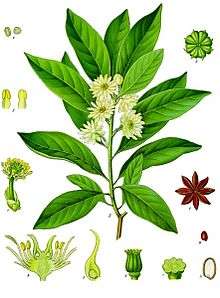Illicium anisatum
| Japanese star anise | |
|---|---|
 | |
| Japanese star anise | |
| Scientific classification | |
| Kingdom: | Plantae |
| (unranked): | Angiosperms |
| Order: | Austrobaileyales |
| Family: | Schisandraceae |
| Genus: | Illicium |
| Species: | I. anisatum |
| Binomial name | |
| Illicium anisatum L. | |
| Synonyms | |

Illicium anisatum, with common names Japanese star anise,[1] aniseed tree,[1] and sacred anise tree,[1] known in Japan as Shikimi (樒, シキミ), is a tree closely related to the Chinese star anise. Since it is highly toxic, the fruit is not edible; instead, the dried and powdered leaves are burned as incense in Japan. Its branches and evergreen leaves are highly considered sacred by Buddhists,[2] due to its ability to last freshly after pruning.
I. anisatum is native to Japan. It is similar to I. verum (Chinese star anise), but its fruit is smaller and with weaker odor, which is said to be more similar to cardamom than to anise. While it is poisonous and therefore unsuitable for using internally, it is used for treatment of some skin problems in traditional Chinese medicine..Additionally, due to its poisonous nature it has been used to kill fish.[2]
Use of leaves eg in tea
Japanese star anise [tea/leaves?] contains anisatin, shikimin, and sikimitoxin, which cause severe inflammation of the kidneys, urinary tract, and digestive organs. Other compounds present in [leaves?] toxic species of Illicium are safrole and eugenol, which are not present in I. verum and are used to identify its adulteration. Shikimi gave its name to shikimic acid, a substance also present in the plant.
Cases of illness, including serious neurological effects such as seizures, that have been reported after using star anise tea may be a result of using this species instead of Chinese star anise (Illicium verum).[3][4][5]
It is impossible to distinguish Chinese and Japanese star anise in its dried or processed form by its appearance only, due to morphological similarities between the species.
Cases of product recalls have been reported when products containing star anise were found to be contaminated by Japanese anise.[3] Cases of consumers admitted to hospital with neurological symptoms after ingesting excessive doses of star anise or smaller doses of products adulterated with Japanese anise were described, as well.[3]
Essential oil components
The essential oil of air-dried I. anisatum obtained by hydrodistillation [of leaves?] was analyzed by GC–MS. Fifty-two components were identified in the essential oil, and the main component was eucalyptol (21.8%).[6]
Anisatin and its derivatives are suspected of acting as strong GABA antagonists.
See also
| Wikimedia Commons has media related to Illicium anisatum. |
References
- 1 2 3 4 "USDA GRIN Taxonomy". Retrieved 6 January 2014.
- 1 2 Simpson, Michael (2010). Plant Systematics. Elsevier. p. 189. ISBN 978-0-12-374380-0.
- 1 2 3 FDA Issues Advisory on “Teas”: Teas Made from Star Anise Were Associated With Illnesses Including Seizures, US Food and Drug Administration.
- ↑ Neurotoxicities in infants seen with the consumption of star anise tea.
- ↑ Perret C, Tabin R, Marcoz JP, Llor J, Cheseaux JJ "Apparent life-threatening event in infants: think about star anise intoxication!". Arch Pediatr. 2011 Jul;18(7):750-3.
- ↑ JI-YOUNG KIM et all, Chemical composition, antioxidant, anti-elastase, and anti-inflammatory activities of Illicium anisatum essential oil, Acta Pharm. 59 (2009) 289-300.